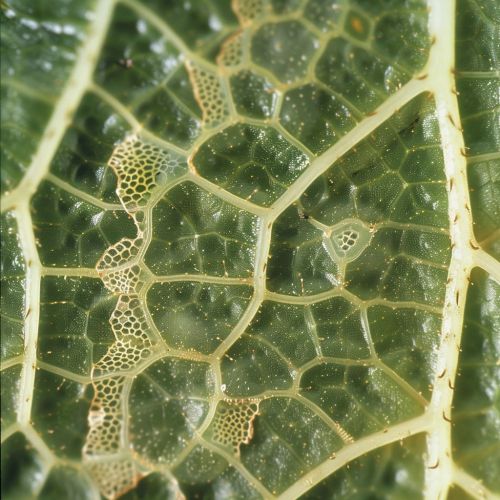Guard Cell
Introduction
Guard cells are specialized plant cells located in the epidermis of leaves, stems, and other organs. They play a crucial role in regulating gas exchange and water loss by controlling the opening and closing of stomata. This article delves into the structure, function, and significance of guard cells, as well as their physiological and biochemical mechanisms.
Structure
Guard cells are typically kidney-shaped in dicotyledons and dumbbell-shaped in monocotyledons. They are part of the stomatal complex, which also includes subsidiary cells and the stomatal pore. The cell walls of guard cells are unevenly thickened, with the inner wall facing the stomatal pore being thicker than the outer wall. This structural asymmetry is essential for their function.


Guard cells contain chloroplasts, which are relatively rare in other epidermal cells. These chloroplasts are involved in photosynthesis and play a role in the regulation of stomatal movements. The presence of chloroplasts also allows guard cells to sense changes in light intensity and quality, which can influence stomatal behavior.
Function
The primary function of guard cells is to regulate the opening and closing of stomata, thereby controlling gas exchange and water loss. Stomata are microscopic pores on the leaf surface that facilitate the exchange of gases, including carbon dioxide, oxygen, and water vapor. When stomata are open, carbon dioxide can enter the leaf for photosynthesis, and oxygen, a byproduct of photosynthesis, can exit. However, open stomata also allow water vapor to escape, leading to transpiration.
Guard cells control stomatal aperture by changing their turgor pressure. When guard cells take up water and become turgid, they swell and curve away from each other, opening the stomatal pore. Conversely, when they lose water and become flaccid, they collapse and close the pore.
Mechanisms of Stomatal Movement
Ion Transport
The movement of ions, particularly potassium (K+), plays a critical role in the regulation of guard cell turgor. When guard cells are stimulated to open, potassium ions are actively transported into the cells from surrounding subsidiary cells. This influx of K+ ions lowers the water potential inside the guard cells, causing water to enter by osmosis. The increased turgor pressure results in the opening of the stomatal pore.
Conversely, when guard cells are stimulated to close, potassium ions are transported out of the cells, increasing the water potential and causing water to exit. The loss of turgor pressure leads to the closing of the stomatal pore.
Role of Abscisic Acid
Abscisic acid (ABA) is a plant hormone that plays a crucial role in the regulation of stomatal closure, especially under drought conditions. When plants experience water stress, ABA levels increase, triggering a signaling cascade that leads to the efflux of potassium ions from guard cells. This results in the loss of turgor pressure and the closing of stomata, reducing water loss through transpiration.
Light and CO2 Sensing
Guard cells can sense changes in light intensity and quality, which influence stomatal movements. Blue light is particularly effective in stimulating stomatal opening. Photoreceptors in guard cells detect blue light and activate proton pumps, leading to the hyperpolarization of the cell membrane and the subsequent influx of potassium ions.
Carbon dioxide (CO2) levels also affect stomatal behavior. High internal CO2 concentrations typically cause stomata to close, while low CO2 levels promote opening. This regulation ensures that the plant maintains an optimal balance between gas exchange and water conservation.
Biochemical Pathways
Photosynthesis in Guard Cells
The presence of chloroplasts in guard cells allows them to perform photosynthesis, albeit at a lower rate than mesophyll cells. The photosynthetic activity in guard cells generates ATP and NADPH, which are used in various metabolic processes, including the regulation of ion transport.
Signal Transduction Pathways
Stomatal movements are regulated by complex signal transduction pathways involving various receptors, secondary messengers, and protein kinases. Calcium ions (Ca2+) act as a secondary messenger in many of these pathways. Changes in cytosolic Ca2+ levels can trigger the activation or inhibition of ion channels, leading to changes in guard cell turgor.
Reactive oxygen species (ROS) and nitric oxide (NO) are also involved in guard cell signaling. These molecules can modulate the activity of ion channels and other proteins, influencing stomatal movements.
Environmental and Physiological Factors
Water Availability
Water availability is a critical factor influencing stomatal behavior. Under drought conditions, plants produce more ABA, leading to stomatal closure to conserve water. Conversely, in well-watered conditions, stomata are more likely to remain open to facilitate gas exchange.
Light Intensity
Light intensity and quality significantly affect stomatal movements. Blue light is particularly effective in promoting stomatal opening, while red light has a lesser effect. The presence of chloroplasts in guard cells allows them to sense light and adjust stomatal aperture accordingly.
Temperature
Temperature can influence the rate of transpiration and, consequently, stomatal behavior. Higher temperatures increase the rate of water evaporation from the leaf surface, potentially leading to increased transpiration and the need for stomatal closure to conserve water.
CO2 Concentration
Internal and external CO2 concentrations play a crucial role in regulating stomatal movements. High internal CO2 levels typically cause stomata to close, while low CO2 levels promote opening. This regulation ensures that the plant maintains an optimal balance between gas exchange and water conservation.
Evolutionary Significance
Guard cells and stomata are believed to have evolved as an adaptation to terrestrial environments. The ability to regulate gas exchange and water loss allowed early land plants to colonize diverse habitats with varying water availability. The evolution of guard cells and stomata was a critical step in the diversification of land plants.
Research and Applications
Research on guard cells has significant implications for agriculture and environmental science. Understanding the mechanisms of stomatal regulation can help develop crops with improved water-use efficiency and drought tolerance. Additionally, studying guard cells can provide insights into plant responses to climate change and environmental stressors.
